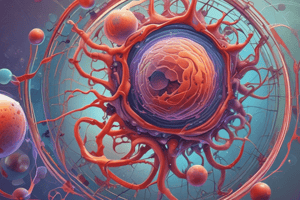Podcast
Questions and Answers
What is the main function of white blood cells in the human body?
What is the main function of white blood cells in the human body?
- To produce hormones that regulate growth
- To carry oxygen throughout the body
- To patrol the bloodstream and attack pathogens (correct)
- To digest food in the stomach
Where are white blood cells made in the human body?
Where are white blood cells made in the human body?
- In the lungs
- In the bones (correct)
- In the brain
- In the liver
What is the term for harmful substances that can make you sick?
What is the term for harmful substances that can make you sick?
- Bacteria
- Leukocytes
- Pathogens (correct)
- Antibodies
What is the name of the most common type of white blood cell?
What is the name of the most common type of white blood cell?
How many white blood cells are typically found in one drop of blood?
How many white blood cells are typically found in one drop of blood?
What is the system in the body that fights against harmful pathogens?
What is the system in the body that fights against harmful pathogens?
What happens when white blood cells detect pathogens in the body?
What happens when white blood cells detect pathogens in the body?
What is another name for white blood cells?
What is another name for white blood cells?
When the body needs extra help against pathogens, what happens to white blood cell production?
When the body needs extra help against pathogens, what happens to white blood cell production?
What do neutrophils primarily fight against?
What do neutrophils primarily fight against?
Flashcards are hidden until you start studying
Study Notes
Protection Cells
- The immune system has special cells called white blood cells that patrol the bloodstream to detect and fight against harmful threats like bacteria, infection, or other pathogens.
- White blood cells are like the police, protecting the body from harm, and are connected to the immune system.
White Blood Cells
- White blood cells are made inside the bones and circulate through the bloodstream in search of pathogens.
- There are between 7,000 and 25,000 white blood cells in one drop of blood, and more can be produced if the body is fighting a serious infection.
- White blood cells are also called leukocytes.
Immune System
- The immune system is the body's defense against harmful pathogens that can cause illness.
- White blood cells are an essential part of the immune system, with five different types, each with a unique job:
- Some fight bacteria
- Others fight allergies
- Others battle parasites
- The most common type, neutrophils, fights pathogens like bacteria and fungi.
Neutrophils
- Neutrophils are the most important type of white blood cell.
- When they detect pathogens in the blood, they spring into action and ingest them, much like a vacuum cleaner.
- Neutrophils look like a bumpy snowball, with a white and bumpy exterior, a nucleus (control center) on the inside, and tiny granules that help digest pathogens.
- The clear liquid inside the cell is called cytoplasm.
Studying That Suits You
Use AI to generate personalized quizzes and flashcards to suit your learning preferences.




